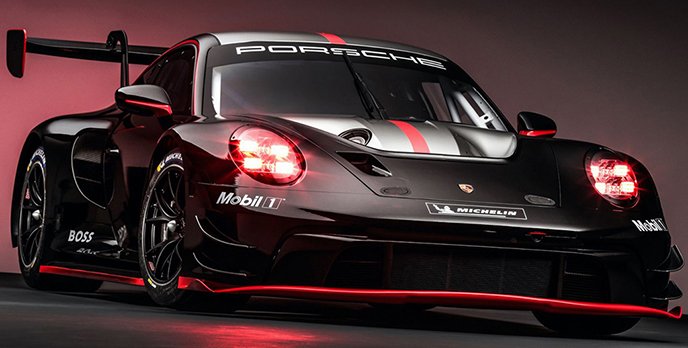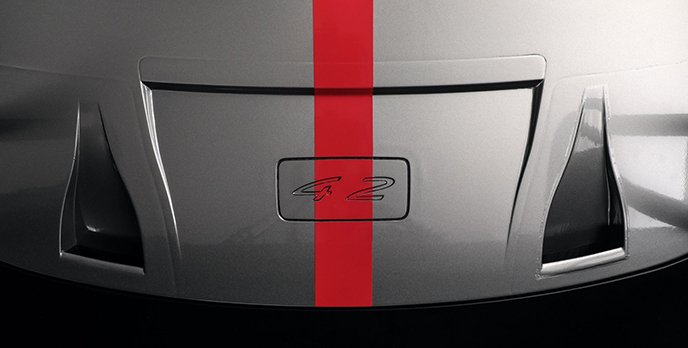Porsche has revealed the 2023 911 GT3 R
03 Aug 2022|842 views
Porsche has unveiled the 2023 911 GT3 R, which has the unenviable task of having to live up to the reputation its predecessor has built. The previous 911 GT3 R won almost all races in the GT3 scene back in 2019, with standout successes at the Nurburgring and Spa-Francorchamps.
With the bar set at a very high level, the emphasis of the engineers was to make the new 911 GT3 R more durable and drivable. This means the new 4.2-litre engine has a broader, more usable rev band, more stable aerodynamics and lower loads on the rear tyres.
The engine of the new 911 GT3 R is similar to the unit of its predecessor, being a water cooled flat six with and direct fuel injection. As you may have noticed, the main improvement is the increase of displacement from 3,997cc to 4,194cc. This results in a boost to power output to around 550bhp.
The remarkable engine has also been tilted forwards by 5.5 degrees, creating more leeway for an underbody diffuser. Auxiliary units like the alternator and air conditioning compressor were moved a metre forward and further down into a space in front of the engine and gearbox which helped improved the car's weight balance.
For the car's suspension, the front axle is an advanced double wishbone layout which controls the wheels. The rear axle meanwhile is a multi-link setup. KW shock absorbers have been improved to offer five adjustable settings.
In the heat of a track battle, being able to shed speed faster will result in better lap times. The brakes of the 911 GT3 R are thus aluminium monobloc racing brake items supplied by AP. The front steel discs are internally vented and slotted, measuring 390mm in diameter and are activated by six pistons. The ABS system has also been enhanced to reduce wear on tyres and brakes.
Porsche's new race car is also a master of aerodynamics. It has an elevated underbody at the fore of the front axle with a smooth undertray and rear diffuser. This combination provides downforce without substantial increase in drag. The stand-out GT3 wings are now swan-neck mounts, ensuring clean airflow under the wing which improved aerodynamic efficiency of the component.
And what about those menacing red LED's on the face of the new 911 GT3 R? Those are high performance LED items which possess collimator technology, first seen on the Porsche LMDh prototype. The device works like a magnifying glass in reverse, being able to illuminate a large area of racetrack.
With the bar set at a very high level, the emphasis of the engineers was to make the new 911 GT3 R more durable and drivable. This means the new 4.2-litre engine has a broader, more usable rev band, more stable aerodynamics and lower loads on the rear tyres.
The engine of the new 911 GT3 R is similar to the unit of its predecessor, being a water cooled flat six with and direct fuel injection. As you may have noticed, the main improvement is the increase of displacement from 3,997cc to 4,194cc. This results in a boost to power output to around 550bhp.
The remarkable engine has also been tilted forwards by 5.5 degrees, creating more leeway for an underbody diffuser. Auxiliary units like the alternator and air conditioning compressor were moved a metre forward and further down into a space in front of the engine and gearbox which helped improved the car's weight balance.
For the car's suspension, the front axle is an advanced double wishbone layout which controls the wheels. The rear axle meanwhile is a multi-link setup. KW shock absorbers have been improved to offer five adjustable settings.
In the heat of a track battle, being able to shed speed faster will result in better lap times. The brakes of the 911 GT3 R are thus aluminium monobloc racing brake items supplied by AP. The front steel discs are internally vented and slotted, measuring 390mm in diameter and are activated by six pistons. The ABS system has also been enhanced to reduce wear on tyres and brakes.
Porsche's new race car is also a master of aerodynamics. It has an elevated underbody at the fore of the front axle with a smooth undertray and rear diffuser. This combination provides downforce without substantial increase in drag. The stand-out GT3 wings are now swan-neck mounts, ensuring clean airflow under the wing which improved aerodynamic efficiency of the component.
And what about those menacing red LED's on the face of the new 911 GT3 R? Those are high performance LED items which possess collimator technology, first seen on the Porsche LMDh prototype. The device works like a magnifying glass in reverse, being able to illuminate a large area of racetrack.
Porsche has unveiled the 2023 911 GT3 R, which has the unenviable task of having to live up to the reputation its predecessor has built. The previous 911 GT3 R won almost all races in the GT3 scene back in 2019, with standout successes at the Nurburgring and Spa-Francorchamps.
With the bar set at a very high level, the emphasis of the engineers was to make the new 911 GT3 R more durable and drivable. This means the new 4.2-litre engine has a broader, more usable rev band, more stable aerodynamics and lower loads on the rear tyres.
The engine of the new 911 GT3 R is similar to the unit of its predecessor, being a water cooled flat six with and direct fuel injection. As you may have noticed, the main improvement is the increase of displacement from 3,997cc to 4,194cc. This results in a boost to power output to around 550bhp.
The remarkable engine has also been tilted forwards by 5.5 degrees, creating more leeway for an underbody diffuser. Auxiliary units like the alternator and air conditioning compressor were moved a metre forward and further down into a space in front of the engine and gearbox which helped improved the car's weight balance.
For the car's suspension, the front axle is an advanced double wishbone layout which controls the wheels. The rear axle meanwhile is a multi-link setup. KW shock absorbers have been improved to offer five adjustable settings.
In the heat of a track battle, being able to shed speed faster will result in better lap times. The brakes of the 911 GT3 R are thus aluminium monobloc racing brake items supplied by AP. The front steel discs are internally vented and slotted, measuring 390mm in diameter and are activated by six pistons. The ABS system has also been enhanced to reduce wear on tyres and brakes.
Porsche's new race car is also a master of aerodynamics. It has an elevated underbody at the fore of the front axle with a smooth undertray and rear diffuser. This combination provides downforce without substantial increase in drag. The stand-out GT3 wings are now swan-neck mounts, ensuring clean airflow under the wing which improved aerodynamic efficiency of the component.
And what about those menacing red LED's on the face of the new 911 GT3 R? Those are high performance LED items which possess collimator technology, first seen on the Porsche LMDh prototype. The device works like a magnifying glass in reverse, being able to illuminate a large area of racetrack.
With the bar set at a very high level, the emphasis of the engineers was to make the new 911 GT3 R more durable and drivable. This means the new 4.2-litre engine has a broader, more usable rev band, more stable aerodynamics and lower loads on the rear tyres.
The engine of the new 911 GT3 R is similar to the unit of its predecessor, being a water cooled flat six with and direct fuel injection. As you may have noticed, the main improvement is the increase of displacement from 3,997cc to 4,194cc. This results in a boost to power output to around 550bhp.
The remarkable engine has also been tilted forwards by 5.5 degrees, creating more leeway for an underbody diffuser. Auxiliary units like the alternator and air conditioning compressor were moved a metre forward and further down into a space in front of the engine and gearbox which helped improved the car's weight balance.
For the car's suspension, the front axle is an advanced double wishbone layout which controls the wheels. The rear axle meanwhile is a multi-link setup. KW shock absorbers have been improved to offer five adjustable settings.
In the heat of a track battle, being able to shed speed faster will result in better lap times. The brakes of the 911 GT3 R are thus aluminium monobloc racing brake items supplied by AP. The front steel discs are internally vented and slotted, measuring 390mm in diameter and are activated by six pistons. The ABS system has also been enhanced to reduce wear on tyres and brakes.
Porsche's new race car is also a master of aerodynamics. It has an elevated underbody at the fore of the front axle with a smooth undertray and rear diffuser. This combination provides downforce without substantial increase in drag. The stand-out GT3 wings are now swan-neck mounts, ensuring clean airflow under the wing which improved aerodynamic efficiency of the component.
And what about those menacing red LED's on the face of the new 911 GT3 R? Those are high performance LED items which possess collimator technology, first seen on the Porsche LMDh prototype. The device works like a magnifying glass in reverse, being able to illuminate a large area of racetrack.
Latest COE Prices
December 2025 | 2nd BIDDING
NEXT TENDER: 07 Jan 2026
CAT A$109,501
CAT B$115,102
CAT C$77,003
CAT E$119,000
View Full Results Thank You For Your Subscription.



























